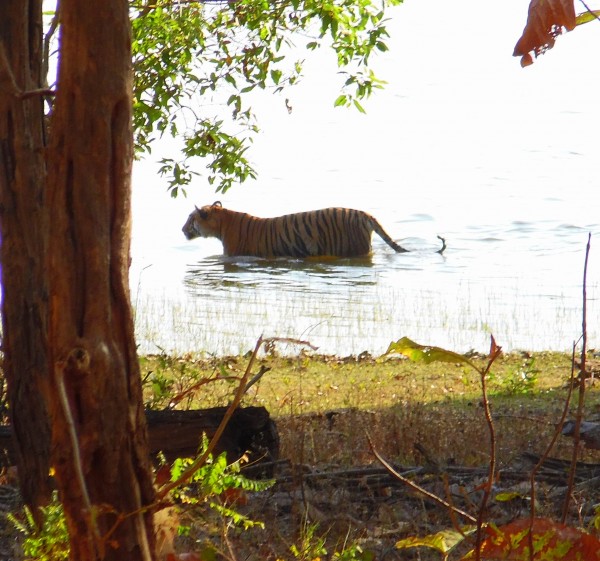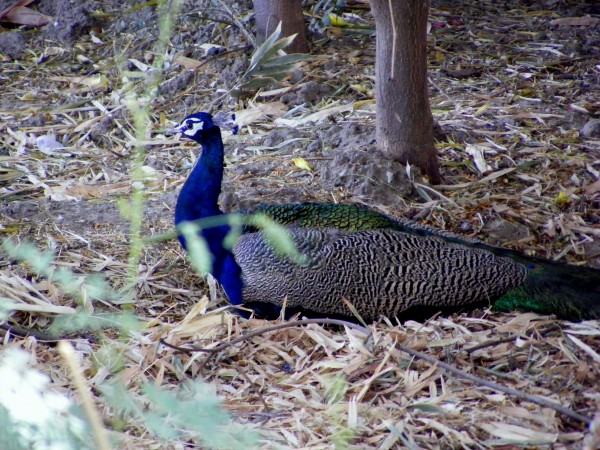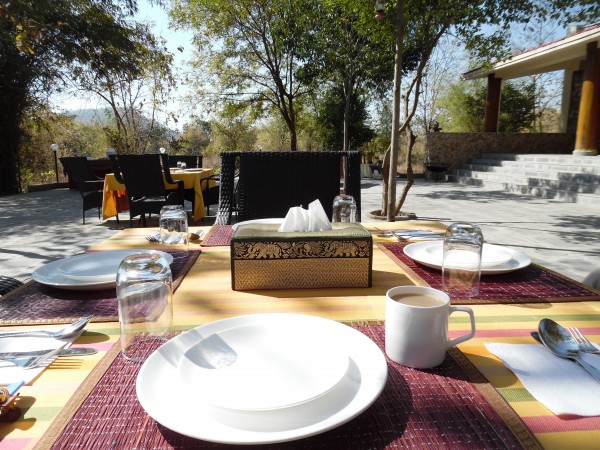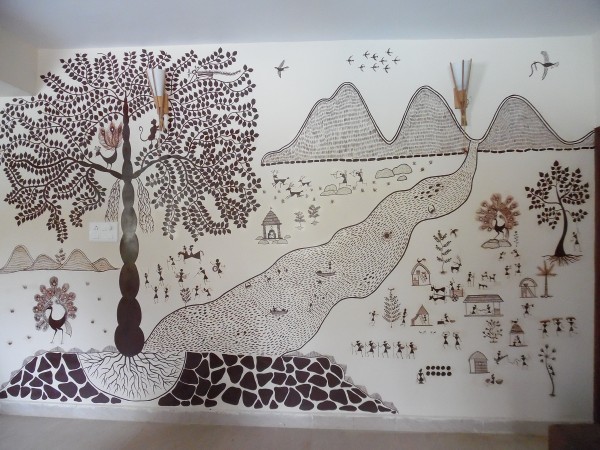Tiger Trails is in Tadoba Andhari Tiger Reserve in the very heart of Central India and two hours south of Nagpur; it is one of India’s most exciting and best protected Tiger Reserves, as yet little known, and with the most visible tiger sightings.
We flew into Nagpur from Bengaluru and were efficiently met by Aditya Dhanwatay the owner of Tiger Trails in February, where we soon learned it had rained, and flummoxed all in that out of season period! Tiger Trails is a pleasant lodge in the Buffer zone of the Reserve with its own water holes which naturally are a great draw to the animals….and I mean all the animals from small to the big cats and the gaur. Being so close to the Entry Gate there is no queuing to enter the Park and the surrounding area is of interest and we went for a guided walk on our last evening as the sun was setting. Dominated by teak forest and bamboo, it’s a rugged landscape comprising cliffs, caves, marshes, perennial lakes and boulder strewn streambeds that cater to a host of biodiversity, not least the Tiger; there are more than 75 to 100 by last count including 24 cubs born last year.
Other prominently spotted wildlife are the Indian Leopard, Indian Wild Dog, Sloth bear, Gaur, Ratel and a variety of mammals and over 280 species of birds including raptors like, Crested Serpent Eagle and Grey Headed Fishing Eagle. Tadoba is special also for rare Indian Owls, like Jungle Owlet, Spotted Owlet, Indian Scops Owl, Brown Fish Owl, Mottled Wood Owl and the Great Indian Horned Owl. Many of these can be heard near our waterhole cottages.
Aditya has a committed Staff with a fine Naturalist Dhamendra and he himself is so knowledgeable. We loved our four nights here and were privileged to see a tigress, bear and a host of other animals. The jeeps are excellent; the accommodation is good but simple, the food is the local cooking with a delightful chef who made both vegetarian and non vegetarian well and then demonstrated his jalebi making expertise one night in front of us – I was in heaven! Camp fires on the terrace, pleasant public areas, sumptuous food, great wildlife observation (along with hides adjacent to the Lodge) – we had a most rewarding time. Below, is breakfast on the terrace.
Nagpur is well served by air routes to Mumbai, Delhi and other big cities and we flew on to Delhi. I particularly loved the heritage link with the past; the Gond kingdom was encompassing of what is now the wildlife park and there are the pillars still in place to show how communication was achieve all those centuries ago. Tadoba has much to offer by way of wildlife, wild beauty, tigers, birds, and a sense of good camp ambience.
Useful Background Information:
Tadoba in 1955 was only 116.55 sq. kms. Today, in 2015 the park stands at 1854.25 Sq. kms. The understanding of the Tadoba park management was that more protected area was required for the growing population of Tiger in Tadoba. In 1995 the first steps to include more adjoining forest areas was initiated with the 508.85 sq. km Andhari Forest block added to Tadoba; thereafter the park name became Tadoba Andhari Tiger Reserve, with a combined size of 625.4 sq.km. Then in May 2010 the State Government notified another additional area of 1,103.34 sq km Tadoba buffer zone. This was done by adding 901.66 sq km with Chandrapur and 76.17 sq km with Brahmapuri was brought under the administrative control of Tadoba field director for better wildlife management. Last year in 2014, 125.51 sq km dense forests leased out to Forest Development Corporation of Maharashtra (FDCM) was finally been brought under the control of Tadoba field director for better wildlife management.
The Tadoba Success Story…
The park management, right from the outset, has been determined that the future of the National park rests with of the surrounding Gond communities. It needed to create an economic vibrancy in the villages surrounding the park, so that the villages could benefit from the park. Nature Tourism along with the local communities was established as one of the ways of going forward. All the new Nature Tourism initiatives were planned along these lines to create employment opportunities for the surrounding communities. The park was successful in creating tourism as a conservation tool by empowering the local tribal people around the park as stake holders. It launched the concept of VEDC (Village Eco Development Committees) funded by CAMPA (Compensatory Afforestation Fund Management and Planning Authority). The first set of villages chosen to be part of the VEDC were the ones closest to the park. These funds are given to each village as seed money for a period of three years, to start tourism initiatives that bring economic vibrancy in the villages surround the reserve.
A moratorium was placed on more than 51 vehicles entering Tadoba’s core, while empowering the Junoana and Devada villages outside core areas to erect a gate and collect fees from visitors who chose to avail of a specially-created wildlife route managed by the village Eco-Development Committees (EDC). Additionally, local youth were trained as wildlife guides. With 15 more routes planned in the protected buffer, these areas promise wildlife sightings comparable to those in the core. The experiment seems to have succeeded. Seeds have been sown for livelihoods that sustain people, while benefitting the tiger.
The Park management wanted two new tourism initiatives to create sensitization towards nature for the park visitor. Hence they started walking trails of about 100 kms in and around the park, covering different habitats, from meadows, Riparian forests, to deciduous Teak and bamboo forests. These areas, namely Agarzari, Junona and Dewada were newly opened up for nature visitors for the first time. Even the regular visitors to Tadoba were amazed at the variety of landscape and wildlife sightings these new ranges offered. For the avid birder each of these walks can reveal more than 120 species of birds. Tadoba, offers some wonderful wildlife experiences. It is also one of the few parks that are open all year round, offering visitors an opportunity to visit in the monsoon season – this extraordinary active time for all manner of plants and animals, yet otherwise closed to keen nature lovers in most other parks of India.
Thickly clad hills form the north and western boundary of the Tiger Reserve. Half way along the western boundary of the Park, the hills contour, to form the Chichghat valley where the TigerTrails Jungle Lodge is located. It is ringed on three sides by the Park Forest and is adjacent to the Khutwanda gate. To the south is the Irai Lake, approx. 20 kms in length and forming the southwestern boundary of the Tiger Reserve. The Lodge, cottages, ancillary buildings and all human supportive infrastructure, is restricted by intention to 2 acres only. Surrounding this, are natural forest, ponds, waterholes, forming an oasis of greenery. The highlight of forest conservation and wildlife protection and its effect on predators and prey in the Tadoba and Mohurli forests, along the western boundary, is the daily activity of 9 adult Tigers and 2 cubs and a range of wildlife, as living proof.
Habitat Regeneration: Barren / Degraded to Natural Forest:
Initially the Chichghat valley was a degraded, barren and deforested land, with stunted trees and a silted Tadoba Stream flowing through only during monsoons. The stream would flow at tremendous velocity during the monsoons, flooding the valley, and carrying away all the valuable silt into the Irai Lake. Over a period, the river was desilted to original depth. We found three natural springs, which were clogged and closed. We cleaned the openings and allowed the three ponds to drain into them .
The water table, which was around 30-40 feet deep from the surface, is today around 8 feet. Because the entire valley was used by the villagers for obtaining firewood, most tree were stumps. These stumps were allowed to grow. With massive plantation of local forest species, recreated the natural forest, and grasslands. Plant Nurseries were established with the help of neighboring Tribal people. They were encouraged with seeds, and plantations techniques. Depending on the type of plants the saplings were transplanted, in natural habitat. Grasslands were cleared of weeds and shrubs. After years of compaction under sustained cattle grazing, ploughing was necessary. The silt and sand from the river was mixed with FYM and spread out. The grasslands were seeded and today it is a green and fertile place and very welcoming to wildlife lovers.
Above, a painting in the lodge.
Aline Dobbie is an author of four books on India and a travel writer. She lives in Scotland but travels widely throughout the year with an annual visit to India where she was born & grew up. Aline’s earlier life was in the corporate world but now lives a rural life with emphasis on travel, gardening, cooking, and family. India, South Africa, England, Scotland, Greece and other lovely places are a constant delight to her.













